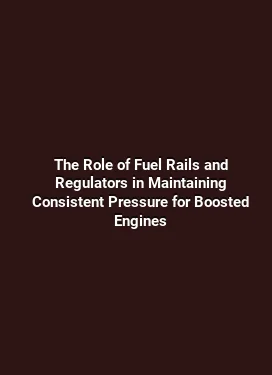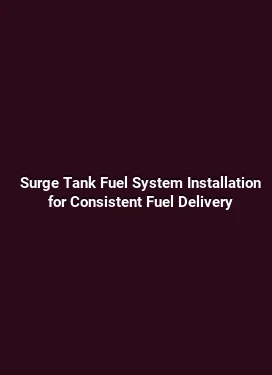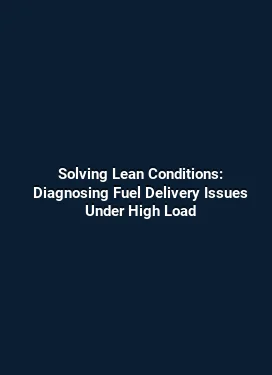Inlet Pipe Upgrade Guide: Reducing Turbo Inlet Restrictions
Turbo systems rely on a free and consistent flow of air to deliver peak performance. The path from the intake manifold to the turbocharger is lined with pipes that can become bottlenecks if not chosen and installed properly. Upgrading the inlet pipe is a practical way to reduce restriction, improve throttle response, and support higher power levels without resorting to more invasive modifications. This guide dives into the specifics of turbo inlet piping, from material choices and design considerations to installation practices and maintenance. It combines practical, field-tested insights with technical reasoning to help enthusiasts make informed decisions that translate into real-world gains.
Understanding Turbo Inlet Restrictions

Airflow restriction in the intake tract occurs for several reasons: pipe diameter, surface roughness, bends, and junctions where the pipe meets the turbo and intercooler. Even a seemingly small reduction in diameter or a sharp bend can create a pressure drop that the turbo must overcome, leading to slower spool and reduced low-end torque. At higher horsepower targets, the cumulative effect of multiple small restrictions becomes more pronounced, as the turbocharger operates closer to its efficiency limit. A thoughtful inlet pipe upgrade targets these weakness points without introducing new vulnerabilities such as heat soak or vacuum leaks.
How Turbocharger Demand Affects Inlet Piping

Turbochargers demand a steady, high-volume, low-turbulence stream of air. When the pipe walls are smooth and the path is as short and straight as possible, air accelerates more efficiently into the compressor. Conversely, elongated paths, elbows with tight radii, and abrupt transitions create turbulent zones that delay air delivery and raise effective intake temperatures. The goal is to maintain a nearly laminar flow profile across the operating range, particularly at the engine’s torque peak. This becomes critical when boosting at higher levels or running with aggressive fueling strategies where every cubic centimeter of air matters.
Choosing the Right Inlet Pipe Material
Material selection influences both performance and durability. Common options include aluminum, high-grade silicone, and reinforced polymers. Each material has distinct advantages in terms of weight, rigidity, heat resistance, and ease of installation.
Aluminum Charge Pipes: Rigidity and Reliability
Aluminum charge pipes are favored for their stiffness, which helps resist deformation under boost pressure. A rigid pipe reduces vibrational fatigue and keeps the internal diameter consistent across a wide temperature range. Anodized finishes also provide corrosion resistance and aesthetic appeal. When choosing aluminum pipes, look for thick-walled construction and precision-bored internal diameters to minimize step changes that can disrupt airflow.
Silicone Charge Pipes: Flexibility and Seal Integrity
Silicone hoses offer excellent heat resistance and flexibility, which can simplify routing around tight engine bays. High-quality reinforced silicone reduces the risk of collapse under vacuum and pressure differentials. A common approach combines silicone hoses with metal reinforcement to strike a balance between pliability and structural integrity. The key is to ensure that clamps are properly torqued and that internal surfaces are smooth to prevent laying a thick lip that could disrupt flow at the compressor entry.
Design Considerations for Improved Airflow
Beyond material choice, the geometry and finish of the inlet path set the ceiling for potential gains. Several design strategies emerge from practical experiments and engineering principles.
Diameter Consistency and Transitional Steps
Maintaining a consistent inner diameter as close to the turbo inlet as possible minimizes flow separation. If an upgrade necessitates a diameter change, a gradual “taper” that increases or decreases diameter over a measured length reduces abrupt transitions. Avoid step changes that create a secondary inlet vortex, which can raise pressure drop and heat the incoming air.
Optimized Routing and Bend Radii
Routing should favor gentle bends with radii that exceed the pipe’s outer diameter by a comfortable margin. Smooth bends reduce localized flow separation and minimize pressure losses. When space constraints demand tighter angles, consider a short, purpose-built elbow with an optimized bend profile rather than multiple generic hoses stitched together. A clean route also facilitates future maintenance and inspection.
Installation Techniques and Best Practices
Installation quality often determines whether an upgrade delivers the expected performance. Thoughtful assembly practices safeguard against leaks, heat transfer, and premature wear. The following steps reflect common-sense approaches used by enthusiasts and technicians alike.
Preparation and Alignment
Before disassembly, inspect all mounting surfaces for debris and ensure mating faces are clean. Dry-fit the components to confirm alignment and clearance with surrounding hardware, such as the alternator belt, intake manifold, and intercooler piping. Any misalignment can cause clamps to loosen or pipe joints to shift under boost. When positioning the pipe, aim for a straight-line path that minimizes the number of clamp points and potential leak paths.
Sealing Surfaces and Clamping
Use high-quality clamps with ample contact area to distribute pressure evenly. For silicone components, consider O-rings or gasketed connectors at critical junctions to improve sealing reliability under extreme temperatures. Lubricants should be avoided on sealing surfaces to prevent contamination. After assembly, verify that all clamps are torqued to manufacturer recommendations and recheck after a break-in period and a few heat cycles to account for clamp settling.
Maintenance and Longevity of Upgraded Inlet Piping
Upgraded inlet piping benefits from a proactive maintenance plan. Regular checks help retain performance while preventing unexpected failures that could compromise engine safety or reliability. Heat, vibration, and chemical exposure all influence the lifespan of inlet components.
Inspection Intervals and What to Look For
Schedule periodic inspections to look for signs of cracking, corrosion, or gasket degradation. Silicone components may show signs of hardening or edge fraying after sustained exposure to high temperatures. Aluminum piping can develop surface oxidation in harsh environments, though anodized finishes slow this process. The key indicators are loose clamps, visible cracks at bend junctions, and any signs of air leaks around joints. Address these issues promptly to maintain consistent boost delivery.
Thermal Management and Heat Soak Prevention
Heat soak occurs when inlet air temperatures rise due to prolonged boost, reducing air density and diminishing performance. Shielding and strategic routing can minimize heat transfer from hot engine components. Some enthusiasts implement heat shields or insulation sleeves on the inlet paths that pass near hot components. However, the most effective approach is to keep the inlet piping away from heat sources and to use intercooler improvements or charge air cooling as a complementary upgrade rather than relying solely on insulation.
Real-World Performance Gains and Testing Methods
Upgrade outcomes vary with engine configuration, tuning, and supporting hardware. The most tangible benefits often include faster spool times, improved throttle response, and a broader effective operating range. Real-world testing typically involves controlled dyno runs, data logging, and careful observation of monitoring parameters such as air-fuel ratio, manifold pressure, and intake air temperature. While numerical gains differ, a well-executed inlet pipe upgrade can unlock smoother power delivery, especially in mid to high rpm ranges where turbocharger efficiency homes in on its sweet spot.
How to Interpret Gains
Increases in low-end torque and quicker response indicate that the turbo is feeding air more efficiently. It’s not solely about peak horsepower; linear power delivery and predictability during corner exits or rapid throttle changes are equally valuable. When evaluating results, compare baseline and upgraded runs under similar weather, fuel, and tire conditions to ensure that observed improvements reflect the upgrade rather than external factors.
Integration with Other Systems: Intercooling, Intake, and Fuel
An inlet pipe upgrade is most effective when paired with complementary enhancements. A well-matched intercooler, efficient piping routing, and a supportive fueling strategy yield the most consistent gains. If the intake system lacks adequate intercooling, the benefits of a cleaner inlet path may be partially muted by rising air temperatures. Similarly, fueling strategies that lean or enrich the mixture can alter how effectively the increased airflow translates into power. Collaborative tuning with a qualified professional helps align these systems to maximize performance while preserving reliability.
Intercooler Compatibility and Pressure Drop
The reduced pressure losses in the inlet tract can shift the overall pressure drop across the charge system. When upgrading piping, ensure the intercooler and piping are sized to maintain proper charge cooling and flow balance. A mismatch can lead to unexpected heat buildup under high boost or during sustained pull-downs in racing scenarios. The takeaway is to view the inlet upgrade as part of an integrated airflow system rather than a standalone component.
Fuel System Considerations During Upgrades
Increased airflow often necessitates corresponding fueling adjustments to avoid lean conditions at the top end. A staged or calibrated fuel strategy ensures the engine maintains the correct air-to-fuel ratio across the RPM range. When planning an inlet upgrade, consider coordinating with fueling hardware such as injectors, pumps, and calibration software to preserve safe operating margins and to leverage the new airflow capacity effectively.
Upgrading the inlet pipe is a measured investment in airflow efficiency. By selecting appropriate materials, optimizing geometry, following meticulous installation practices, and integrating with intercooling and fueling improvements, a turbocharged engine can realize meaningful, repeatable gains in responsiveness and power delivery without resorting to invasive modifications.
First Steps to Begin Your Upgrade Project
Begin with a clear assessment of your current setup. Examine pipe routing, clamp quality, and any signs of wear or heat damage. Define performance goals—whether that means faster spool, stronger mid-range torque, or improved throttle response—and choose components that align with those targets. Budget for high-quality connections and seals to minimize leaks, and plan for a proper break-in period after installation to allow components to settle. With a systematic approach, an inlet pipe upgrade becomes a practical, repeatable way to enhance turbo performance while maintaining reliability across daily driving and spirited sessions alike.






